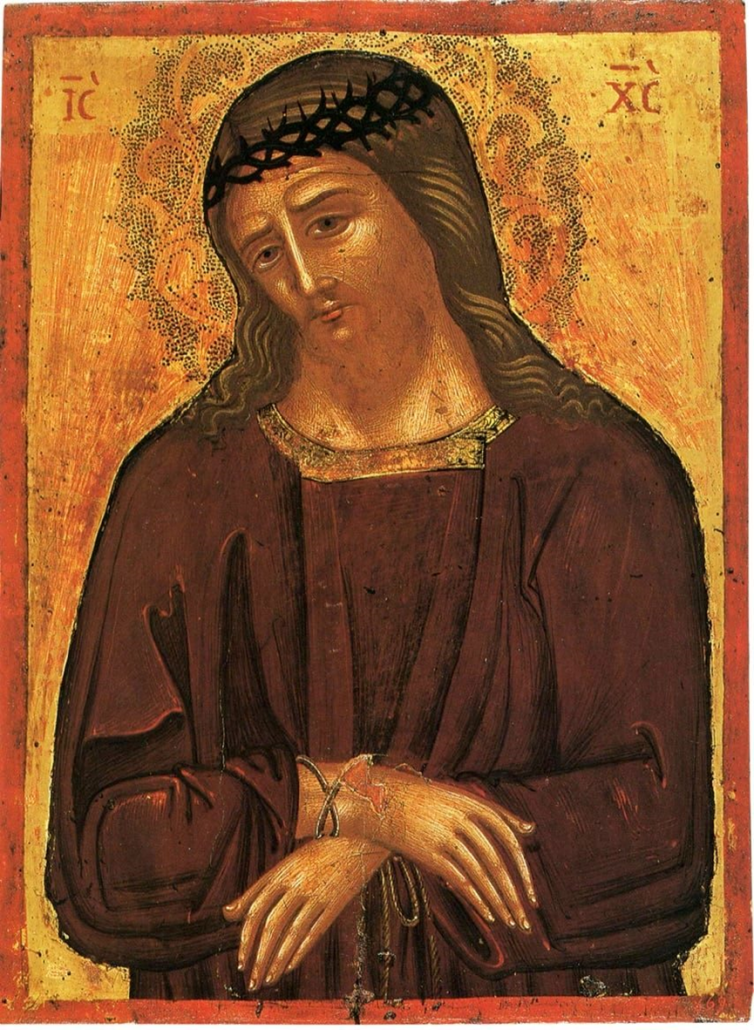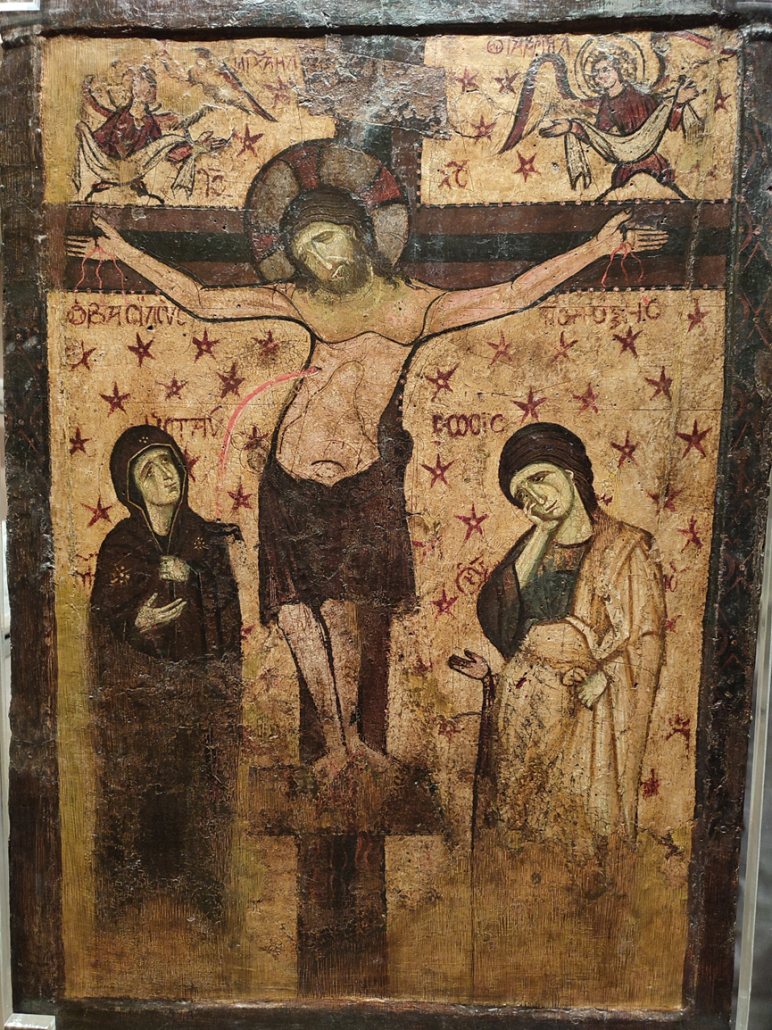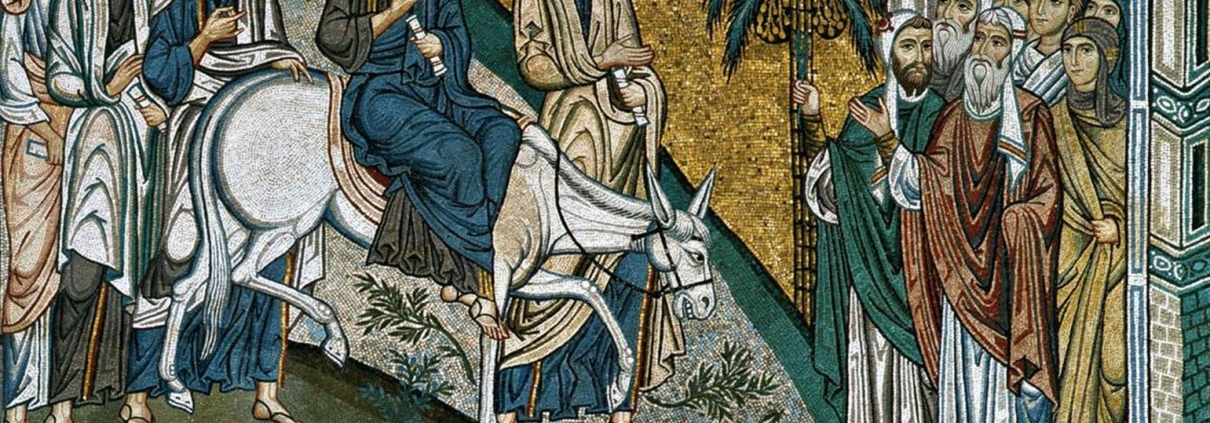IN THE HOLY CHURCHES OF THESSALONIKI
Introduction
The Holy Week, or Passion Week, is celebrated in the churches of Thessaloniki with devoutness and with numerous ecclesiastical services. The believers actively participate and prepare for the joyful event of Christ’s Resurrection. In the streets and neighborhoods, the customs and folk traditions associated with this period are evident.
We call the Passion Week the Holy Week, not because of the length of the hours, but because the person is our Lord.
According to sources in Jerusalem, they have used the designation “Holy Week” since the 4th century.
Lazarus Saturday and Palm Sunday have the unique place in the church year as days of joy between Lent and the mourning of Holy Week. They are outside the period of Lent, which ends on the Friday before Palm Sunday.
On Palm Sunday, “fish is eaten,” as it is considered a great Feast of the Lord, and the strict fasting (abstention from animal products) of Great Lent, which has preceded it, and that of Holy Week following it, is interrupted.
Palm Sunday

The Holy Week begins. This day commemorates the memory of Jesus’ triumphal entry into Jerusalem, where, according to the Evangelists of the holy Gospels, the Judean greeted Him warmly, holding vayas (palm branches – symbols of victory) and, spreading their clothes on the ground, cheered “Hosanna, blessed is he who comes in the name of the Lord”.
By the end of the Divine Liturgy, the priests distribute to the faithful the Vayas, which have previously been blessed in all the churches of the city during the Orthodox service.
The first three days of Holy Week, namely Palm Sunday, Holy Monday and Holy Tuesday, constitute a single, liturgical unity, preparing us spiritually for the divine drama and the Vespers are called the “Bridegroom’s services”, because the well-known troparion “Behold, the Bridegroom Christ will come suddenly at midnight” is chanted in the churches. “And blessed is the man who will find himself spiritually awake, while on the other hand he is unworthy who will find himself sluggish and negligent. Beware, then, my soul, lest you be overcome by sleep, lest you give yourself up to the death of sin and find yourself outside the kingdom of God, but take heart, crying aloud, holy, holy, holy art thou our God, have mercy on us with the protection of the holy angels.”
Palm Sunday afternoon
Two events are dominant:
- The life of Joseph, the so-called Pangalos, that is, the handsome in body and soul, eleventh son of the patriarch Jacob. Joseph, who was sold as a slave to the Egyptians, prefigures in his adventure Christ Himself and His passion. This is a great Old Testament figure, about whom we read in the last section of the book of Genesis.
- The incident of the fruitless fig tree that Jesus dried occurred the day after His triumphal entry into Jerusalem. It is a living exhortation to believers to produce spiritual fruit.
Holy Monday afternoon
In the Sequence of the Bridegroom of that day we remember two parables:
- Of the ten virgins, which teaches us to be ready and prudent, like the five wise virgins, and full of faith and works of charity.
- Of the talents, which teaches us to be industrious, to cultivate and increase our spiritual gifts.
The two parables are instructive and of utmost importance for our salvation, reminding us of the Second Coming of the Lord.
Holy Tuesday afternoon

In the matins service we remember the repentance of the sinful woman who, out of gratitude, anointed the feet of the merciful Lord with precious myrrh just before His Passion and was forgiven for her sins because she showed great love and faith in Christ.
This event was preserved by all four Evangelists with some minor differences in their narratives.
Moreover, on this day we remember the betrayal of Judas.
The last hymn in that day’s service is that of the pious and scholarly Byzantine poet and melodist, the nun Kassiani, who lived during the reign of Emperor Theophilos (829-842). It is one of the most beautiful hymns in Orthodox church hymnography and at the same time, it conveys special messages about God’s boundless love and forgiveness.
The choice of a hymn, written by this particular historical person for liturgical use during Holy Week, conveys timeless messages about the equality of the sexes and the divine love for the female sex!
Holy Wednesday afternoon

The sacrament of Unction
On Holy Wednesday in the afternoon, along with the Sequence of Holy Washbasin, the sacrament of Unction for the sanctification of the believers , in order to cure their physical and spiritual illnesses.
The sacrament of Unction on the words of St. James the Brother of God:
At the end of the service, the priests chrism (i.e., anointing) the faithful with the holy oil crosswise on the forehead, the chin, the two cheeks, the palms and the outside of the hands.
On that day, the Church in her hymnal reminds us of 4 events that occurred shortly before the Passion of the Lord.
- the Holy Washbasin
- the Last Supper
- the prayer of Jesus in the Garden of Gethsemane and
- the betrayal of Judas
The Fathers of our Church have determined that we celebrate the great events that took place on the day our Christ was arrested. According to the holy Gospels, on the fifth day of that week the Lord, as God, knowing what was about to happen, wished to dine with His disciples for the last time. For this He arranged a table in a certain high place in Jerusalem. This supper took place in the evening and is called the Last Supper, because during it great events took place.
Jesus washed the feet of His disciples at the Last Supper, summing up the meaning of His ministry. Nowadays, usually in the cathedral, the high priest washes the feet of 12 priests in a re-enactment of the event, according to the sequence contained in a separate, liturgical book.
Holy Thursday morning

The main theme of the day is the celebration of the sacrament of the Eucharist.
On the same day, according to a folk tradition, accepted by the Church, believers boil eggs and paint them red, in memory of the bloody sacrifice of Jesus on the Cross, while in some houses, in the courtyards or on the balconies they hang a red cloth.
Holy Thursday afternoon

In the evening, during the service, twelve passages from the Gospels are read, describing the events from the arrest to the burial of Christ.
On the same evening the ceremony of the Crucifixion of Christ takes place. After the fifth Gospel, the Crucifix comes out of the Sanctuary, accompanied by Priests and Cantors : “Today he hangs on the wood of the cross who hung the earth on the waters”, the priest chants, as he carries the crucified Jesus into the temple. After the procession is completed, the Cross is placed in the centre of the temple, the faithful venerate the Crucifix and place wreaths and flowers at His base.
It is the climax of the divine drama. Then the “Passion Sequence” is celebrated and we remember and experience the Saving and horrible Passion of our Lord and God, namely: the spitting, the scourgings, the mockeries, the humiliations, the beatings, the crown of thorns and, above all, the Crucifixion and death of Christ.
After the evening service, women usually decorate the Epitaph and the canopy, in which the Epitaph is placed, with flowers. The Epitaph is a cloth on which the Lord of the Dead is embroidered or painted. The flowers symbolize the perfumes of the interred and the myrrh-bearers. Often in the Bible, flowers are used to glorify divine wisdom.
Jesus also makes reference to the fleeting beauty of flowers, especially lilies, to convince His hearers that man should trust in God’s providence.
Holy Friday morning

On Holy Monday morning the Great Hours are chanted, which include many hymns and the Deposition of the Crucified. The Epitaph is decorated with flowers and placed in the wooden canopy (symbolizing the deathbed). And then the faithful worship it. The churches remain open to worshippers until the evening service.
We are introduced to the atmosphere of the Holy Saturday by the glorification of the Holy Friday Vespers, which is chanted in a rhythmic, but at the same time mournful sound. The Lord has breathed his last and Joseph, boldly asking permission from the Roman ruler Pilate, descends with Nicodemus the lifeless body of Jesus.
On Good Friday morning, shops remain closed until 12 noon as a sign of mourning and respect.
Holy Friday afternoon

In the Holy Friday evening, the hymn is about the burial of the Lord by Joseph and Nicodemus and the descent of His soul to Hades, where He preached to all the dead.
During the service, praises are chanted, small hymns, very dear to the people, by an unknown poet. Afterwards, the procession of the Epitaph and the cube is made outside the church and in the streets of the church area.
In the Metropolis of Thessaloniki it is customary for the Epitaphs of the Metropolitan Church of St. Gregory Palamas and the Cathedral of the Sophia of God to meet.
During the meeting priests and faithful chant together.
Epitaphs are also found in other parishes of our city. During the procession of the Epitaph, a custom with ancient roots, which is lost in the depths of the centuries, bands play mournful marches and mournful bells sound from the bells of the churches. The faithful participate in the procession of the Epitaph and follow, holding lit dark-coloured candles in mourning.
Except that the procession of the Epitaph of the holy church of St. Minas in the city center takes place at noon in the center of the market, so that professionals and workers have the blessing to worship it.
Holy Saturday (First Resurrection)
The Holy Saturday marks the end of the Passion Week. It is the only Saturday of the year on which we also fast from oil.
On the morning of Holy Saturday, Vespers and the Liturgy of the Great Basil are celebrated in the churches, ushering us into the celebration of the next day, namely the Resurrection of the Lord.
The service of that morning has a joyful and celebratory character. It is called the “First Resurrection”.
After the reading of the prophecy of Jonah, which prefigures the three-day burial and Resurrection of the Lord, the priests inside the churches throw laurel leaves (bay leaves) to the faithful, which symbolize victory and joy (that is, the victory of Christ over death, His Resurrection).
In many churches, metallic objects or seats are loudly struck. This custom symbolizes the clangor and excitement for the anticipated Resurrection of Jesus. In the Resurrection Gospel of the same day, we read that Jesus addressed the women with the Greek greeting “Rejoice.” With this greeting, the Risen Lord honors the women.
Holy Saturday night

The services of Easter Sunday, the matins and the Divine Liturgy of Saint John Chrysostom, are celebrated at midnight on Holy Saturday in all the churches of our city. The Cathedral of our city, dedicated to the Wisdom of God, is presided over by Metropolitan Philotheos of Thessaloniki.
The services of Easter Sunday, the Matins and the Divine Liturgy of Saint John Chrysostom, are celebrated at midnight on Holy Saturday in all the churches of our city. The Cathedral of our city, dedicated to the Wisdom of God, is presided over by Metropolitan Philotheos of Thessaloniki.
On the night of Holy Saturday, at 11:30, the lights of the churches are turned off and the Archpriest in the Cathedral comes out to the Holy Doors, holding candles with Light from the unlit candelabrum, which is inside the sanctuary, and chanting “Receive Light…”, that is: “Come receive light from the unfallen light”. The same happens in the other churches of our city, while the faithful hold white candles and candles and light them.
Afterwards, the Archpriest, the priests, the cantors, the rulers and the faithful go out into the courtyard of the cathedral, where the Gospel of the Resurrection is read and at 12:00 midnight the “Christ rose from the dead, having conquered death by His death and given life to the dead who were in the tombs” is chanted. The bells of all the churches in our city ring joyfully to convey the message of the Resurrection and fireworks and firecrackers “light up” the night!Αρχή φόρμας
The faithful light their candles, kiss each other, exchange resurrection wishes (Christ is risen!) and crack the eggs, painted in red.
The Easter candle custom dates back to early Christian times, when newly converted Christians were baptized on Holy Saturday and Easter Sunday after a period of preparation. The candle they held in their hand symbolized the new light of Christ, which would now illuminate the soul of the new convert.
The candle is lit for the first time on the night of the Resurrection, to emphasize that Christ is the light of the world and His commandments are a light on the path of our lives.Αρχή φόρμας
Easter Sunday morning
The Vespers of Love is celebrated in the morning at the Metropolitan Church of St. Gregory Palamas, presided by the Metropolitan of Thessaloniki, with a number of priests. The same service is celebrated in the other churches of our city in the evening at 7.00.
In the service, a passage from the Gospel of John is read, which refers to the appearance of Christ after His resurrection to His disciples, except for Thomas, who was not present, was not convinced of the event and asked for proof. Christ appears and greets them with “Peace be with you” because His disciples were in need of peace.
The passage is also read in foreign languages, in order to emphasize that the Resurrection concerns the whole world and has a universal dimension.
The service is called the “Vespers of Love” because Christ was crucified and resurrected out of love for people.
The meaning of the Resurrection
The Resurrection of Christ is the solid rock upon which the “One, Holy, Catholic and Apostolic Church” is built.
The Gospels of the New Testament do not describe the resurrection of Christ, but record testimonies and experiences of the disciples who met the Risen Christ or visited the empty tomb where the martyrs heard from the angel: “He is not here, for, as he said, he is risen”. The same is true of the Byzantine icons of the Resurrection: it is not the event itself that is depicted, but its anthropological consequences. The Risen Christ takes a man, Adam, and a woman, Eve, by the hand and brings them out of the darkness of Hades, uniting them.
The Resurrection will always proclaim that “the powers of hell shall not overcome the Church”.
The message “Christ is risen” is the most beautiful song, the greatest comfort and the brightest guide on the dark and sad paths of history. Upon “Christ is Risen” rests all that is most beautiful and most high in our faith. The risen Christ opened heaven and raised man from death to life, from corruption to incorruption and eternity.









